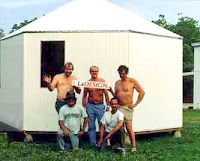We are located less than 50 miles south of the US border in San Diego, having access to 2 container terminals within one hour (Ensenada MX and San Diego CA). We have what is hailed as the best weather year-round in North America. We have a pool of good laborers and we consistently form long-lasting skills with our employees and associates. Our shop is situated next to the toll highway and 400 feet from our office situated on the other side, by the sea. We are building right now an extension to house our material laboratory and eventually our design office and classroom for 12. Our training program are already being promoted to foreign clients and we expect to start training specialized crews this coming winter. Meanwhile our offices are in one part of my private residence and that is working fine for now.

Good results can only be had when the social and physical environments for work are good. We are proud to say that our Cantamar location provides the best possible scenario for the
development of ideas that fit the client's need perfectly. Our proximity to the USA gives quick access to specialists, some materials, high-tech tools and instruments when needed, and quick access to what are reputed to be the best airport in each country. In addition, the friendly atmosphere created by our Mexican co-workers in

ideal to help shape the qualities that we expect to develop in our students of construction, of plant management or work site supervision. We are totally happy at the Institute and we will love sharing that creative joy with you. JBP. Dir.











